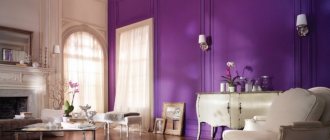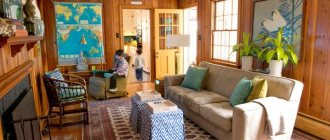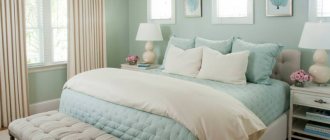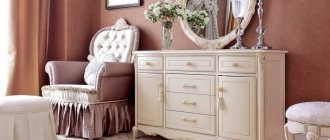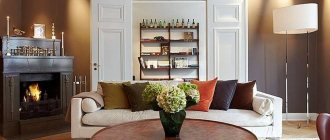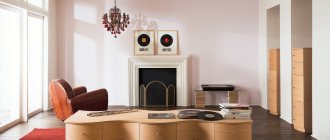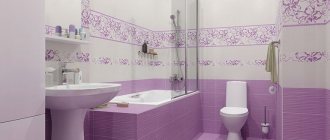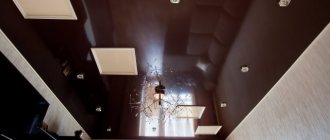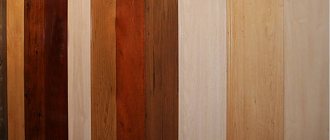The beige color is so typical for a person that he may not see it at all.
In nature, it can be found everywhere in the form of various objects. The color of a person's skin, like a child's skin in beige tones, is almost the same.
What is so good about this color in the interior of a children's room?
- A good background for light colors.
- For example, for curtains and toys of different colors, etc.
- Perfect for a small room with poor lighting.
- Unlike the white range, the children's room in beige does not get dirty and makes cleaning easier.
- Reduces child's hyperactivity. Improves mood.
- Beige wallpaper in a child's room will provide him with security.
Pairs well with a range of colors:
- Blue or with blue;
- Brown;
- Whitish;
- Black;
- And green.
Age
For a newborn’s room, it would be better to focus on a pastel color so that the child cannot be distracted from sleep. Various examples of this design are publicly available on the Internet.
At three years old, a child begins to understand the world, so light colors are appropriate here. Beige is a good combination with many light colors. The main thing is not to forget that these shades must be saturated.
For teenagers over 11 years old, different combinations are allowed. Beige color can balance even dark tones, let alone bright ones. If you look the other way, beige can be used as a calm color, which is also relevant at the moment.
Practicality and benefits of beige color in the room
Unlike pure white, beige shades are easier to maintain. Wallpaper, furniture upholstery, pastel pillows are easier to wash and clean. Another plus is ease of perception, beneficial effect on the psyche. The beige background helps balance children with hyperactivity. It increases concentration, reduces activity, and normalizes sleep.
Natural beauty and abundance
The beige color is not striking, but one cannot help but notice its beneficial effects. It is found everywhere in the form of sand and stone, wood and plants. A person perceives it very easily and combines it with almost any color of the spectrum. The color harmonizes perfectly with products in blue and light blue, azure and white, black and brown, green and turquoise.
Universal schemes in which the background is beige, additional design in neutral colors (light blue, turquoise) and there is a bright accent (lemon) always pay off. Additional white and bright orange colors will look good against this background. When decorating the interior, you need to take into account the child’s personal preferences, as well as pay attention to age.
Furniture and curtains
Typically, real materials have their own natural beige color, so don’t forget about this when planning your design.
For example, you can choose bamboo, linseed, and possibly beige curtains for a child’s room. The furniture, for example, is made of ash, and the carpet is made of sisal.
Choosing a shade based on the gender of the child
Girls prefer cream wall options. Against its background, lilac, pink, and lavender shades look harmonious. For boys, it is better to choose olive and sand options, which can be complemented with blue and light blue, green and orange designs. For children of different sexes, it is recommended to select universal combinations of beige with green, red, orange, yellow and blue.
Look at these photos of beige interiors for girls:
Age criteria
For babies, beige color is the best option for decorating a room. From the age of three, children are actively getting to know the world, and bright accents against a light background will stand out well. It is important that third-party colors are clean and not flashy. Teenagers can choose brighter and bolder combinations. Beige allows you to tame bright colors and brightens dark objects. When choosing a shade, pay attention to the size of the room and its level of lighting.
The following photos clearly show the differences in the design of a teenager’s and a child’s room:
Area and lighting
Small rooms with poor lighting can be enlivened with light and cream tones and contrasted by combining them with orange and red, pink and coral. A blue accent will help add a touch of freshness. Any beige option is suitable for decorating spacious rooms. A cool breeze will create a secondary blue, turquoise, aqua color. Let's also pay attention to interior styles, where beige is the leader.
Different shades of beige create different moods in the room.
Interior styles
Beige shades will optimally fit into any interior style. This is one of the main color options in Provence and Country, Mediterranean and palace, minimalist and classic design options. Thematic paintings in the form of a safari park or an Indian tribe will harmoniously fit into a beige room.
The following photos show a beige room in a marine and English style.
And the traveler style is ideal for a boy’s room. Check out these photos:
Materials
To bring a natural beige color into the interior, you can use linen curtains and bamboo products, ash and rotunda furniture, and sisal carpets. If you need to get a room for growth, then it is better to use beige as a background. You should choose appropriate wallpaper or paint for the walls. Cabinets, flooring, chairs and paintings can have more expressive shades (brown, blue, green). Curtains, furniture upholstery, rugs, pillows, decorations and other easily replaceable items should be made bright.
Photos of children's room interiors in beige color
aaeae
And this beige room for kids looks simply magical. Contrasting colors will make the interior of a beige children's room more cheerful. Beige rooms for two children: And such a children's room will help the child throw out excess energy.
Room decoration based on the height of the child
In order to properly make a room for growth, the color of the walls must be beige. The flooring must be covered, and the furniture must be large in size.
For example, a closet or an alternative - a chest of drawers; bed or sofa. Everything that can be easily replaced should be in color, such as curtains, pillows, and so on.
Combination methods
Method 1. Vertical combination
The technique involves decorating walls with alternating canvases of two colors/types or more. Vertical combination is good because it allows you not to join the pattern and not be “embarrassed” by the visibility of the seams. On the contrary, joints and vertical stripes will visually raise a low ceiling.
If you use more than two types of coatings, then you should select only one accent wall for this combination.
Rolls should be chosen with a width of no more than the standard 53 cm.
Below are photo examples of vertical wallpaper combinations in a children's room.
Method 2. Horizontal combination
This method is more traditional, since it resembles the classic decoration of the lower third of the walls with boiserie panels or lining, only instead of them there is the same wallpaper. The joints are most often covered with paper or any other borders.
However, the dividing line does not have to run in a straight line - perhaps it will be arcs, waves and even zigzags.
Keep in mind that combining canvases horizontally visually expands the room, but lowers the ceiling. This solution is also not suitable for highlighting an accent wall; using the described method you need to cover all the walls of the room.
How high should the bottom “tier” be? There are no strict rules here, but most often the sides are glued at a height of 1.10 cm from the floor.
At the bottom you need to glue wallpaper of a darker shade, and at the top - a lighter shade.
When using a border, you can combine wallpaper of different types, that is, of different densities and thicknesses. For example, you can stick a more practical vinyl underneath, then your baby’s graffiti can be washed off.
Method 3. Highlighting niches, ledges or accent walls
This technique involves the design of any niche, ledge, accent wall or its fragment. For this purpose, bright wallpaper, for example, photo wallpaper, is combined with plain coverings or with coverings with a calm pattern (polka dots, stripes, diamonds, checks, etc.) in a neutral color.
To zone a children's room, you need to highlight a wall near the bed, study table or play area.
By highlighting a niche, ledge or one wall with dark-colored wallpaper, and decorating the remaining surfaces in light colors, you can visually distance the wall, which means “enlarge” it a little and give depth to a small space.
Next, we present photo examples of zoning and highlighting an accent wall using wall decoration from two types of wallpaper.
Method 4. Creating a panel
In this case, bright and calm companions are also combined. The panels are limited by moldings or frames.
This decorative technique is an excellent reason to use leftover wallpaper.
Method 5. Decorating not only the walls, but also the ceiling
Companion wallpaper can be used not only to decorate walls, but also the ceiling. In this case, the child will be able to look at interesting pictures on it before going to bed.
For a small and low children's room, finishing the ceiling and walls with wallpaper is only available with light wallpaper.
Method 6. Patchwork style combination
Zoning a room or highlighting an accent wall can also be created using a combination of pieces of wallpaper of different colors, types and sizes using the patchwork technique. Since the “patchwork” wall turns out to be variegated, the second companion should be monochromatic.
A patchwork wall looks great in a country style, shabby chic, bohemian and Scandinavian interior.
Method 7. Creating “optical illusions”
By decorating the walls with wallpaper of different colors, you can change the proportions of the room. So, in order to expand a narrow and long room, you need to cover the ends with light canvases, and the long walls with darker ones.
And, conversely, you can add intimacy to a spacious room by covering the ends with darker coatings, and the long walls with lighter ones.
Photo of beige children's room design
The influence of color on a child's psyche
An error in the color design of a nursery will eventually affect the behavior of the owner of the room. If a child is attacked by unusual attacks of activity or apathy, it is difficult for him to fall asleep or concentrate on any task, it may be due to the wrong color scheme. Therefore, it is important to take into account the characteristics of shades when choosing the main color for a children's room; psychology points to the following properties:
- Red. It not only invigorates and energizes, but also constantly keeps the nervous system in good shape. It is better not to get carried away with the color red, especially in a space intended for a baby. It can be used in doses and preferably not in decoration, but in accessories, otherwise whims are guaranteed.
Red accessories Source rehouz.info
- Orange. Also not among the leaders for decorating a nursery; its excess easily leads to overwork. Moderate use improves mood, so an accent wall, a couple of orange toys or an orange print on curtains (bed linens) won't go amiss.
Orange zoning Source st.hzcdn.com
- Yellow. It improves mood and has a positive effect on the intellect, but, like other bright colors, it is used as an additional color. The pale yellow version is good as a background tone, especially for shy children.
Sunny room Source cdn.lifehacker.ru
- Blue, light blue. These colors, together with numerous shades, calm, relax, and relieve nervous tension. They can be safely used in the play area of a little fidget, but limited to young Pierrot’s room.
Positive interior Source design-homes.ru
- Green. It subconsciously connects with nature, therefore it has a positive effect: it calms the nervous system, relaxes the eyes, improves memory. Light shades of green are refreshing, and therefore green is suitable for decorating a classroom.
Pistachio in the children's interior Source www.gbvims.org
- Purple, lilac. Bright, rich shades tire the psyche of a small child and distract attention. They cannot be made with primary colors; it is better to use the light version - light and pastel colors.
- Pink. In large quantities it affects the baby, just like purple. The recipe for use is the same.
Pink in homeopathic doses Source breakpr.com
See also: Catalog of companies that specialize in the construction of turnkey country houses
Color design
Human vision perceives one color in combination with others, so a purely beige nursery is rare; in addition, bright colors must certainly be used to create an atmosphere in the room. The following combinations are used in the design:
- pastel colors - light blue, soft pink and pale lilac. When combined with the main tone, they become a source of warmth, harmony, and comfort;
- shades of noble metals complement the ordinary, familiar interior with unusual accents, adding elegance and originality;
- brown plus beige - a universal pair. These are natural paints belonging to the same color range. This is a suitable option for a child’s room, as the room in warm colors creates a calm environment. Ideal color ratio: 20% in dark colors, 80% in light colors;
- beige plus pink is a color pair suitable for a girl’s nursery. With this combination, you can easily create a pleasant environment with bright nuances. The bright interior of the bedroom with harmoniously selected textiles and draperies, mirrors of various shapes and decorative details will appeal to young ladies. This environment will allow them to feel like princesses who will delightfully spend time in their palace.
The beige color, coupled with the listed variations, helps create a calm, comfortable environment in the nursery, which has a positive effect on the child’s psycho-emotional state. Plus, the room will always look fresh and bright, regardless of the light level.
Using green
Green is considered a universal color, around which boys and girls of all ages feel comfortable. Green is surprisingly diverse. It includes many shades, from delicate light green to deep malachite, including bright turquoise, lime and menthol.
Green has many interesting shades Source etcontrol.co
The combination of two natural tones in a beige and green interior gives the bedroom a light, refreshing look. If you like the idea of a nursery in beige tones in combination with green, think over the color scheme taking into account whether cold or warm shades will be combined:
- When the base is beige in a cold tone, closer to gray. Against the background of such walls, warm varieties of greenery will look especially gentle: light green, apple, olive.
Light green and cold background Source behance.net
- Beige walls in a warm tone, closer to peach. A good addition would be rich emerald, turquoise, sea green; The space has acquired a touch of luxury.
With a touch of Tiffany Source houzz.com
